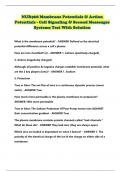Exam (elaborations)
NUR968 Membrane Potentials & Action Potentials - Cell Signaling & Second Messenger Systems Test With Solution
- Course
- Institution
NUR968 Membrane Potentials & Action Potentials - Cell Signaling & Second Messenger Systems Test With Solution...
[Show more]



